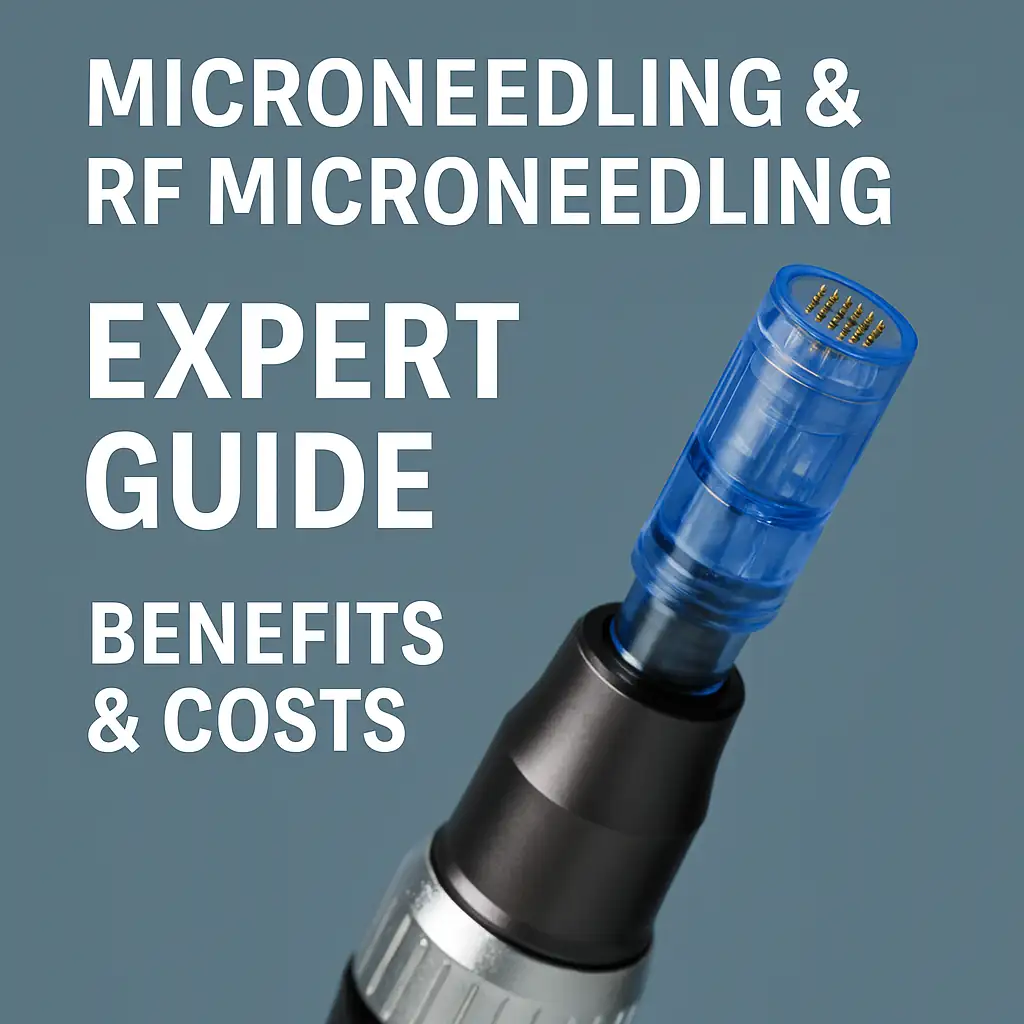Last updated: October 2025

What Is Microneedling
Microneedling, also called collagen induction therapy, uses arrays of sterile needles to create micro-channels in the epidermis and superficial dermis. These controlled injuries trigger wound-healing cascades that upregulate collagen I/III and elastin, improving fine lines, texture, pores, and mild scars. Histology and clinical studies show increased dermal thickness and organized collagen with repeated sessions (Fabbrocini 2014; Hou 2014).
What Is RF Microneedling
Radiofrequency (RF) microneedling adds controlled thermal energy through insulated or non-insulated needles at adjustable depths. Devices in this category include platforms like Morpheus8, Genius RF, Potenza RF, and Scarlet RF. RF energy contracts collagen and heats deeper dermis compared with manual microneedling, which can yield more tightening and scar remodeling when parameters are matched to the patient (Shauly 2023 review).
Scientific Evidence and 2025 Clinical Findings
Evidence supports both modalities:
- Microneedling for texture and scars: Prospective studies show significant improvement in atrophic acne scars and rhytides after three to six sessions, with favorable safety across lighter skin types and cautious use in darker tones (Hou 2014; Fabbrocini 2014).
- RF Microneedling for tightening and scars: Randomized and controlled trials report superior or comparable outcomes to non-RF comparators for acne scars, pores, and lower-face laxity when multiple sessions are performed (Min 2015 RCT; Niaz 2025 systematic review).
- Pigment-prone skin and melasma maintenance (RF): Conservative RF microneedling protocols can aid maintenance and reduce relapse risk in melasma when combined with sun protection and topical regimens (Han 2024; Jung 2019).
Microneedling vs. RF Microneedling
- Microneedling: best for surface texture, fine lines, pores, and mild acne scars with minimal downtime.
- RF Microneedling: adds tightening and deeper remodeling for acne scars, early jowling, neck crepe, and stretch marks; downtime remains manageable.
- Many patients combine both approaches across a plan to address both texture and tightening.
Ideal Candidates
- Fine lines, enlarged pores, uneven texture, and superficial sun damage
- Mild to moderate atrophic acne scars and post-acne texture changes
- Early lower-face laxity or crepey neck (RF microneedling)
- Fitzpatrick I–VI when parameters and aftercare are adjusted appropriately
Who Should Avoid or Delay
- Active infection or inflammatory acne nodules in the treatment area
- Recent isotretinoin use without clinician-guided washout
- History of keloids or abnormal scarring without physician clearance
What To Expect
- Visit time: typically 30 to 60 minutes per area
- Comfort: topical anesthetic for both; RF adds brief warmth/pressure
- Sessions: most plans are 3 to 4 sessions spaced 4 to 6 weeks apart for best results
- Results: progressive smoothing and firmness as collagen remodels over 2 to 3 months
Recovery and Downtime
- Microneedling: pinkness like a sunburn for 24 to 48 hours; flaking may occur day 2 to 4
- RF Microneedling: similar pinkness/swelling for 1 to 3 days with pinpoint marks that fade as skin heals
- SPF and gentle skincare are essential; avoid heat and strenuous workouts for 24 to 48 hours
Cost of Microneedling & RF Microneedling in Los Angeles, 2025
Skin Works Medical Spa (South Bay, Los Angeles): We provide transparent quotes by area and plan. Typical 2025 ranges we see in Los Angeles and the South Bay:
- Microneedling (full face): $300 to $600 per session
- Microneedling with biologic boosters (e.g., growth-factor serums): $450 to $900 per session
- RF Microneedling (face/neck): $800 to $1,800 per session depending on device, depths, and energy
- Series & packages: 3 to 4 sessions reduce the effective per-session cost and help maintain momentum
View our service pages for details and to request an itemized quote: Microneedling at Skin Works and RF Microneedling at Skin Works.
Financing
We offer flexible monthly payments through CareCredit, Klarna, and Affirm (subject to approval). Most patients apply financing to a multi-session package for the best overall value.
Possible Side Effects
- Temporary redness, swelling, pinpoint bleeding, or tenderness
- Short-term dryness or flaking as micro-channels heal
- Rare risks include infection or pigment change; these are minimized with expert technique and aftercare
Do Microneedling Treatments Work
Yes. Published data and reviews confirm visible improvement in texture, pores, fine lines, and atrophic acne scars after a series of microneedling sessions, and additional tightening and scar remodeling with RF microneedling when parameters match your goals. Combination plans can further enhance outcomes when indicated.
Questions To Ask Your Provider
- Manual microneedling or RF microneedling for my goals, and why
- Which needle depths, energy levels (if RF), and session count do you recommend
- What is the total cost including aftercare and follow-up
- How do you tailor treatment for my Fitzpatrick type and acne scar pattern
- Should I combine with peels, lasers, or biologic boosters for better results
Summary
Microneedling refines texture and pores with minimal downtime. RF microneedling adds tightening and deeper remodeling for scars and early laxity. In Los Angeles, expect $300 to $600 per microneedling session and $800 to $1,800 for RF microneedling, with 3 to 4 sessions delivering the best results. Packages and financing through CareCredit, Klarna, and Affirm make multi-session plans straightforward.
References
- Fabbrocini G, et al. Microneedling in clinical practice. J Dermatolog Treat. 2014. PubMed
- Hou A, et al. Percutaneous collagen induction for atrophic acne scars. Dermatol Surg. 2014. PubMed
- Min S, et al. Fractional microneedle RF vs comparator for acne/scars. 2015. PubMed
- Niaz G, et al. RF microneedling for acne scarring: systematic review (2025). PubMed
- Han HJ, et al. RF microneedling in melasma maintenance (2024). PMC
- Jung JW, et al. Laser toning + microneedle RF vs laser alone in melasma (2019). PMC
- Shauly O, et al. RF microneedling devices, indications, safety across skin types (2023). PMC